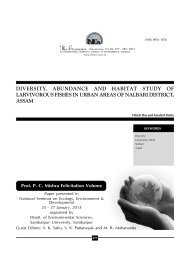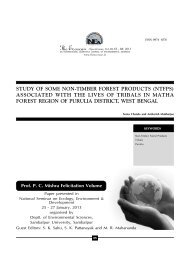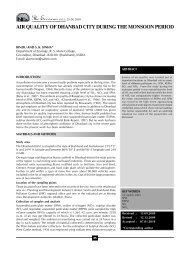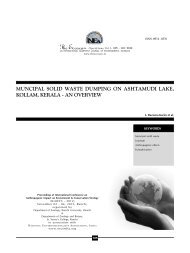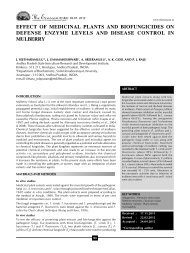SHAILENDRA KUMAR SINHA.pmd
SHAILENDRA KUMAR SINHA.pmd
SHAILENDRA KUMAR SINHA.pmd
Create successful ePaper yourself
Turn your PDF publications into a flip-book with our unique Google optimized e-Paper software.
NSave Nature to Survive<br />
QUARTERLY<br />
6(1&2): 47-50, 2012<br />
47<br />
www.theecoscan.in<br />
TEMPORAL PHYTOPLANKTON DIVERSITY IN TWO PERENNIAL<br />
WATER BODIES (RANI POND AND RAJA POND) JHARIA COALFIELD<br />
OF DHANBAD (JHARKHAND) DURING MONSOON OF 2004-2006<br />
<strong>SHAILENDRA</strong> <strong>KUMAR</strong> <strong>SINHA</strong>*, RUPAM MALLIK 1 AND ABHISHEK 2<br />
Department of Zoology, P K Roy Memorial College, Dhanbad – 826 004<br />
1 Department of Zoology, SSLNTM College, Dhanbad<br />
2 Kavya Communications, New Delhi<br />
e-mail: sinhashailendra66@gmail.com<br />
INTRODUCTION<br />
Water is one of the most essential natural resources available to mankind. In coal<br />
mining and industrial areas, the surface water and groundwater is usually polluted<br />
and contaminated. Coal mining is a developmental activity which is bound to<br />
damage the natural ecosystem directly or indirectly. The biodiversity of the aquatic<br />
ecosystem is adversely affected by mining and industrial operations in the vicinity.<br />
Irrespective of the mining methods employed, mining is bound to cause various<br />
environmental problems and one of them is water pollution. Besides this, sewage<br />
and industrial effluents water are also present in coal mining areas (Nikhil Kumar,<br />
2005).<br />
The Jharia Coalfield (JCF) is a highly industrialized area having coal mining as the<br />
main activity. There are a number of lentic water bodies in the colliery and<br />
industrial areas in Jharia Coalfield of Dhanbad region. Most of the water bodies in<br />
JCF are polluted because of mining and industrial activities. Discharge of<br />
uncontrolled and untreated industrial and sewage wastewater is the major source<br />
of pollution.<br />
Before mining activities started in JCF, a good floral and faunal diversity existed<br />
there. This floral and faunal diversity, both terrestrial and aquatic biodiversity<br />
decreased after mining activities set in<br />
The biodiversity of aquatic ecosystems depends largely on the quality of the<br />
water which, in turn, is dependent upon the extent of mining and industrialized<br />
operations and the manner of management of wastes in the vicinity. The aquatic<br />
flora and fauna which occupy prominent position in terms of their ecological and<br />
economic values are responsible for the preservation of aquatic ecosystem. The<br />
objective of this study is to examine species diversity (phytoplanktons) and<br />
pollution indicators of JCF.<br />
Jharia Coal Field (JCF) lying between 23º29’ to 23º48’ N L and 86º11’ to 86º27’<br />
E L spread over an area of 450 km2 . The field is roughly sickle shaped its longer<br />
axis running northwest and smaller in southeast. This Coalfield belongs to<br />
Gondwana group of Permian age and has Talcher, Barakar, Barren and Raniganj<br />
measures. The coal basin extends for about 38km. in the east-west direction and<br />
a maximum of 18km. in the north-south direction. The total reserve of the area is<br />
estimated to be 16.4 billion tons including 4.3 billion tons of prime coking coal<br />
(Chandra, 1992).<br />
There are several lentic and lotic water bodies in the Jharia Coalfield. Damodar is<br />
the main river. The chief ponds are Rani Pond, Bekar Bandh, Raja Pond, Rejali<br />
pond, Matkuria Talab, etc. Besides ponds, there is several seasonal and perennial<br />
shallow lentic water bodies located in different parts of JCF.<br />
ABSTRACT<br />
Qualitative and quantitative analyses of<br />
phytoplankton have been done in monsoon<br />
season for two consecutive years (2004-2006).<br />
During monsoon of 2004, a total of 20 genera<br />
were identified from Rani pond. The<br />
phytoplankton density was found between<br />
677U/L to 730U/L. The genus Diatoms were<br />
present in highest number while Closterium<br />
was present in least number. During monsoon<br />
of 2005 the phytoplankton density was found<br />
in the range of 436U/L to 486U/L. The genus<br />
Diatoma was the most abundant taxa while<br />
Cosmarium was present in least number.A<br />
total of 18 genera were identified from this<br />
pond. Raja pond is located in coalmine area<br />
of BCCL at Jharia. It is the most polluted pond<br />
of the area as it receives sewerage of Jharia<br />
town. In Raja pond Chlorophyceae was the<br />
most dominant class in monsoon season in<br />
both the years. In monsoon of 2004, the<br />
phytoplankton density was in the range of<br />
296 to 310U/L. The genus Microcystis was<br />
the most abundant taxa while Spirogyra was<br />
present in least number. A total of 14 genera<br />
were identified at Raja pond. During<br />
monsoon of 2005, the phytoplankton density<br />
was found in the range of 352 to 393U/L. The<br />
genus Oscillatoria was the most abundant taxa<br />
while Eudorina was present in least number.<br />
A total of 13 genera were identified from this<br />
pond.<br />
KEY WORDS<br />
BCCL<br />
Phytoplankton<br />
Chlorophyceae<br />
Cyanophyceae<br />
Received : 09.01.2012<br />
Revised : 29.03.2012<br />
Accepted : 01.05.2012<br />
*Corresponding author
<strong>SHAILENDRA</strong> <strong>KUMAR</strong> <strong>SINHA</strong> et al.,<br />
Table 1: Species composition and density of phytoplankton in rani<br />
pond (Monsoon, 2004)<br />
Phytoplanktons July August Sept.<br />
Anabaena sp. 28 24 33<br />
Bacillaria sp. 43 56 50<br />
Closterium sp. 6 3 6<br />
Cymbella sp. 60 56 46<br />
Chlamydomonas sp. 20 20 16<br />
Cosmarium sp. 6 10 13<br />
Diatoma sp. 86 86 83<br />
Euglena sp. 43 26 30<br />
Eudorina sp. 36 30 26<br />
Fragilaria sp. 70 83 55<br />
Microcystis sp. 16 16 10<br />
Nostoc sp. 8 18 20<br />
Navicula sp. 56 90 90<br />
Nitzchia sp. 23 30 20<br />
Oscillatoria sp. 22 24 30<br />
Pandorina sp. 16 10 13<br />
Pithophora sp. 10 22 20<br />
Staurastrum sp. 73 70 56<br />
Spirogyra sp. 40 36 44<br />
Volvox sp. 34 20 16<br />
696 730 677<br />
Table 2: Species composition and density of phytoplankton in rani<br />
pond (Monsoon 2005)<br />
Phytoplanktons July August September<br />
Anabaena sp. 10 13 10<br />
Closterium sp. 13 30 23<br />
Cymbella sp. 43 46 36<br />
Chlamydomonas sp. 10 26 21<br />
Cosmarium sp. 8 12 7<br />
Diatoma sp. 73 86 66<br />
Euglena sp. 23 27 16<br />
Eudorina sp. 16 13 18<br />
Fragilaria sp. 66 60 56<br />
Microcystis sp. 10 13 18<br />
Nostoc sp. 6 8 11<br />
Navicula sp. 76 53 46<br />
Oscillatoria sp. 10 28 14<br />
Pandorina sp. 27 12 20<br />
Pithophora sp. 18 21 28<br />
Staurastrum sp. 18 15 16<br />
Spirogyra sp. 10 7 14<br />
Volvox sp. 11 16 16<br />
448 486 436<br />
Anthropogenic activities, urbanization, land reclamation and<br />
accelerated industrialization have resulted in pollution of<br />
majority of lotic and lentic water bodies (Prasannakumari et<br />
al., 2003). Polluted aquatic ecosystem exerts adverse impact<br />
on the aquatic flora and fauna and causes loss of biodiversity.<br />
The physico-chemical nature of water bodies affects the<br />
aquatic flora and fauna altering their number and biodiversity.<br />
The pond ecosystem undergo maximum diurnal and seasonal<br />
changes when compared to other lotic system (Khatri, 1985;<br />
Munshi and Munshi, 1995).<br />
The species diversity of planktonic and epiphytic rotifers of<br />
the Delhi segment of Yamuna River has been reported by<br />
Arora and Mehrotra (2003). The water quality index of river<br />
Sanamachhakandana at Keonjhargarh, Orissa have been<br />
reported by Bhanja and Patra (2000).<br />
48<br />
The objective of the present study is to study the qualitative<br />
and quantitative studies of pollution indicating species of<br />
phytoplanktons as reported by Arora (1966). Oscillatoria,<br />
Nitzschia, Anabena Navicula, Spirogyra, Cosmariumare<br />
pollution indicating phytoplanktons.<br />
MATERIALS AND METHODS<br />
Two perennial ponds of JCF namely Rani Pond and Raja pond<br />
were selected for the present study.<br />
Rani Pond is located around the residential area of Dhanbad<br />
district away from coal mines. This pond does not receive any<br />
domestic sewage or industrial effluents but washermen and<br />
local residents extensively use this pond for their daily chores.<br />
Raja pond is located in coal mining area of BCCL at Jharia. It is<br />
the most polluted pond of Jharia because it receives sewerage<br />
of Jharia town.<br />
Periodic sampling was done at both the sites in Monsoon<br />
season for two consecutive years.<br />
Sample was collected from the surface and sub-surface as<br />
well. The most common counting method used to quantify<br />
preserved phytoplankton samples is the Utermohl Technique<br />
(Utermohl, 1958) and as modified by Nauwerck in 1963<br />
(Nauwerck, 1963). Staining is not required in this method<br />
because samples are preserved in Lugol’s solution. This<br />
method involves settling a known volume of sample into a<br />
counting chamber. The volume of subsample settled will<br />
dictate the density of phytoplankton. (Findlay and Kling, 2001).<br />
RESULTS AND DISCUSSION<br />
Qualitative and quantitative analyses of phytoplanktons of<br />
Rani Pond and Raja Pond have been done in monsoon season<br />
for the two consecutive years.<br />
Rani Pond<br />
The phytoplankton composition and density at Rani Pond in<br />
monsoon 2004 are shown in Table 1. In July the phytoplankton<br />
density was 696U/L while in August and September months,<br />
it was 730 and 677 U/L respectively. The genus Diatoma was<br />
present in highest number while Closterium was present in<br />
least number. A total of twenty genera were identified from<br />
this site. Four ‘class’ of algae viz. Cyanophycea, Chlorophyceae,<br />
Bacillariophyceae and Euglenophyceae represented the<br />
phytoplankton communities at this site. Chlorophyceae<br />
accounted for nine taxa while Cyanophyceae represented<br />
only four genera. Six species represented Bacillariophyceae<br />
while a single taxon belonged to Euglenophyceae. Staurastrum<br />
was the most abundant taxa while Closterium was the<br />
abundant taxa from Chlorophyceae. Anabaena and<br />
microcystis were respectively the most abundant and the least<br />
represented taxa from the class Cyanophycea. Diatoma and<br />
Nitzchia were, respectively, the mostabundant and least<br />
represented taxa from Bacillariophyceae.<br />
Phytoplankton compositions in both years in terms of class<br />
percentage have been shown in Fig. 1.<br />
Among the phytoplanktons, Bacillariophyceaewas the most<br />
dominant group in both the years of study. 51.4% of the<br />
phytoplanktons recorded belonged to Bacillariophyceae, 32%
Table 3: Species composition and density of phytoplankton in Raja<br />
pond (Monsoon 2004)<br />
Phytoplanktons July August Sept.<br />
Anabaena sp. 22 34 38<br />
Closterium sp. 36 23 23<br />
Chlamydomonas sp. 24 18 20<br />
Cosmarium sp. 26 22 20<br />
Diatoma sp. 24 26 18<br />
Euglena sp. 13 10 16<br />
Eudorina sp. 13 13 18<br />
Fragillaria sp. 26 23 20<br />
Microcystis sp. 33 40 36<br />
Navicula sp. 20 23 20<br />
Oscillatoria sp. 30 26 23<br />
Pithophora sp. 14 10 16<br />
Staurastrum sp. 16 20 18<br />
Spirogyra sp. 13 16 10<br />
310 304 296<br />
Table 4: Species composition and denstiy of phytoplankton in Raja<br />
pond (Monsoon 2005)<br />
Phytoplankton July August Sept.<br />
Anabaena sp. 34 38 42<br />
Closterium sp. 30 32 32<br />
Chlamydomonas sp. 34 28 30<br />
Cosmarium sp. 25 23 28<br />
Diatoma sp. 34 46 26<br />
Eudorina sp. 12 8 14<br />
Fragillaria sp. 34 28 12<br />
Microcystis sp. 34 36 43<br />
Navicula sp. 44 38 30<br />
Oscillatoria sp. 54 48 36<br />
Pithophora sp. 18 22 20<br />
Staurastrum sp. 18 16 15<br />
Spirogyra sp. 22 28 24<br />
393 391 352<br />
Table 5: Classification of phytoplankton based on water quality of<br />
the habitat<br />
Taxa Clean water Polluted Wastewater<br />
algae water algae Treatment<br />
Plant Algae<br />
Pinnularia +<br />
Oscillatoria +<br />
Nitzchia +<br />
Anabaena<br />
Spirulina<br />
+<br />
Clostridium +<br />
Navicula + +<br />
Euglena +<br />
Spirogyra +<br />
Staurastrum +<br />
Cosmarium +<br />
Chlorella +<br />
Closterium +<br />
Chlamydomonas +<br />
belonged to Chlorophyceae, 11.8% to Cyanophycea and<br />
4.7% to Euglenophyceae in Monsoon 2004.The<br />
phytoplankton composition in monsoon 2005 was similar to<br />
that in the monsoon months of 2004.<br />
The phytoplankton composition and density in Monsoon<br />
2005 are shown in Table 2. In July a total of 448 individuals<br />
49<br />
TEMPORAL PHYTOPLANKTON DIVERSITY<br />
were present per litre while in August and September months,<br />
the phytoplankton concentrations were respectively 486 and<br />
436 U/L. The genus Diatoma was the most abundant taxa<br />
while Cosmarium was present in least number. A total of 18<br />
genera were identified at this site. Four ‘class’, namely<br />
Cyanophycea, Chlorophyceae, Bacillariophyceae and<br />
Euglenophyceae represented the phytoplankton community<br />
in this season as well. Chlorophyceae accounted for 9 taxa<br />
while Cyanophyceae and Bacillariophyceae represented four<br />
genera each.<br />
Raja pond<br />
The phytoplankton composition and density at Raja pond in<br />
Monsoon 2004 are shown in Table 3. In July, a total of 310<br />
individuals were present per litre while in August and<br />
September months, the phytoplankton concentrations were<br />
respectively 304 and 296 organisms per litre. The genus<br />
Microcystis was the most abundant taxa while Spirogyra was<br />
present in least number. A total of 14 genera were identified at<br />
this pond. Four ‘class’ of algae viz. Cyanophyceae,<br />
Chlorophyceae, Bacillariophyceae and Euglenophyceae<br />
represented the phytoplankton communities at Raja Pond.<br />
Chlorophyceae accounted for 7 taxa while Cyanophyceae<br />
represented 3 genera. 3 species represented Bacillariophyceae<br />
while a single taxon belonged to Euglenophyceae. The taxa<br />
belonging to Chlorophyceae were Chlamydomonas,<br />
Closterium, Eudorina, Pithophora, Stawrastrum, Cosmarium,<br />
and Spirogyra. Taxa belonging to Cyanophyceae were<br />
Microcystis, Oscillatoria and Anabaena. The three taxa<br />
representing Bacillariophyceae were Fragilaria, Navicula and<br />
Diatoma sp. Euglenophyceae was represented by single genus,<br />
i.e. Euglena. Chlorophyceae was the most dominant class.<br />
Closterium was the most abundant taxa while Spirogyra was<br />
the least abundant taxa from Chlorophyceae. Microcystis and<br />
Oscillatoria were respectively the most abundant and least<br />
represented taxa from the class Cyanophyceae. Only 3 species<br />
were reported from Bacillariophyceae.<br />
The result of quantitative analysis of phytoplankton during<br />
monsoon of 2005 has been shown in Table 4. In July the<br />
phytoplankton density was 393 U/L while in August and<br />
September months it was 391 and 352 U/L respectively. The<br />
genus Oscillatoria was the most abundant taxa while Eudorina<br />
was present in least number. A total of 13 genera were identified<br />
in Raja Pond during monsoon of 2005. Three ‘class’ of algae<br />
viz. Cyanophyceae, Chlorophyceae and Bacillariophyceae<br />
represented the phytoplankton community in this season as<br />
well. Chlorophyceae accounted for 7 taxa while<br />
Cyanophyceae and Bacillariophyceae represented 3 genera<br />
each. Chlorophyceae was the most dominant class.<br />
Closteriumwas the most abundant genus while Eudorina was<br />
the least abundant taxa from Chlorophyceae. Only 3 species<br />
were reported from Bacillariophyceae.<br />
Phytoplanktons have been classified on the basis of their<br />
occurrence in clean water or polluted water in Table 5. A<br />
glance at the table indicates that Oscillatoria sp, Nitzchia sp.,<br />
Anabaena sp., Euglena sp., Spirogyra sp., Chlorella sp. and<br />
Chlamydomonas sp. have been established to be present in<br />
polluted water (APHA, 2000). Studies on phytoplankton<br />
diversity in response to abiotic factors in Veeranam lake in the<br />
Cuddalore district of Tamil Nadu shows that maximum
<strong>SHAILENDRA</strong> <strong>KUMAR</strong> <strong>SINHA</strong> et al.,<br />
Parcentage composition<br />
60<br />
50<br />
40<br />
30<br />
20<br />
10<br />
0<br />
phytoplankton diversity was during post-monsoon season and<br />
minimum diversity was observed in pre-monsoon season<br />
(Senthil Kumar and Sivakumar, 2008). In the present study<br />
however most of these taxa were found to be present at almost<br />
both the sites. Thus, it can be concluded that both the study<br />
stations are polluted to some extent and degree of pollution<br />
can be established from the results of water quality-analysis<br />
and zooplankton studies.<br />
REFERENCES<br />
Chlorophyceae Cyanophyceae Euglenophyceae Baccilariophyceae<br />
Monsoon 2004 - 05 Monsoon 2005-06<br />
Figure 1: Phytoplankton composition at Rani pond during 2004-06<br />
Arora, G. L. 1966. Arch. Hydrobiol. 61: 482-493<br />
Arora, J. and Mehra, N. K. 2003. Species diversity of planktonic and<br />
epiphytic rotifers in the backwaters of the Delhi segment of the Yamuna<br />
river, with remarks on new records from India. Zoological Studies.<br />
42(2): 239-247<br />
Bhanja, K. M. and Patra, A. 2000. Studies on the water quality index<br />
of river Sanamachhakandana at Keonjhargarh Orissa India. Pollution<br />
Research. 19(3): 377-385<br />
Chandra, D. 1992. Jharia Coalfield. Geological Society of India,<br />
Bangalore. pp.1-11.<br />
50<br />
Parcentage composition<br />
45<br />
40<br />
35<br />
30<br />
25<br />
20<br />
15<br />
10<br />
5<br />
0<br />
Chlorophyceae Cyanophyceae Euglenophyceae Baccilariophyceae<br />
Monsoon 2004 - 05 Monsoon 2005-06<br />
Figure 2: Phytoplankton composition at Raja pond during 2004-06<br />
Findlay, D. L. and Kling, H. J. 2001. Protocols for measuring<br />
biodiversity: Phytoplankton in Freshwater. Ecology Monitoring and<br />
Assessment Network Publication, Canada.<br />
Khatri, T. C. 1985. Physicochemical features of Idulkki reservoir,<br />
Kerala during pre-monsoon period. Eviron. Ecol. 3: 134-137.<br />
Munshi, J. D. and Munshi, J. S. D. 1995. Fundamentals of Freshwater<br />
Biology. Narendra Publishing House, Delhi.<br />
Nauwerck, A. 1963. Die Beziehungenzwishchen Zooplankton und<br />
Phytoplankton im See Erken.Symbot Ups 17: 1-163.<br />
Nikhil, K. 2005. Biotreatment of Polluted Water vis-à-vis Socio-<br />
Economic Development in Coal Mining Area. J Indl. Polln Countl.<br />
2(2): 195-199.<br />
Prassanakumari et al. 2003. Surface water quality of river Neyyar,<br />
Thiruvananthapuram, Kerala, India. Pollution Research. 22(4): 515-<br />
525.<br />
Senthil Kumar, R. and Sivakumar, K. 2008. Studies on Phytopankton<br />
Diversity in Response to Abiotic Factors in Veeranam Lake in the<br />
Cuddalore district of Tamil Nadu. J. Environmental Biology. 29(5):<br />
747-758.<br />
Utermohl, H. 1958. ZurVervolkommnung der quantitativen<br />
phytoplankton Methodik. MittintVertheorangeev Limnol. 9: 1-38.





